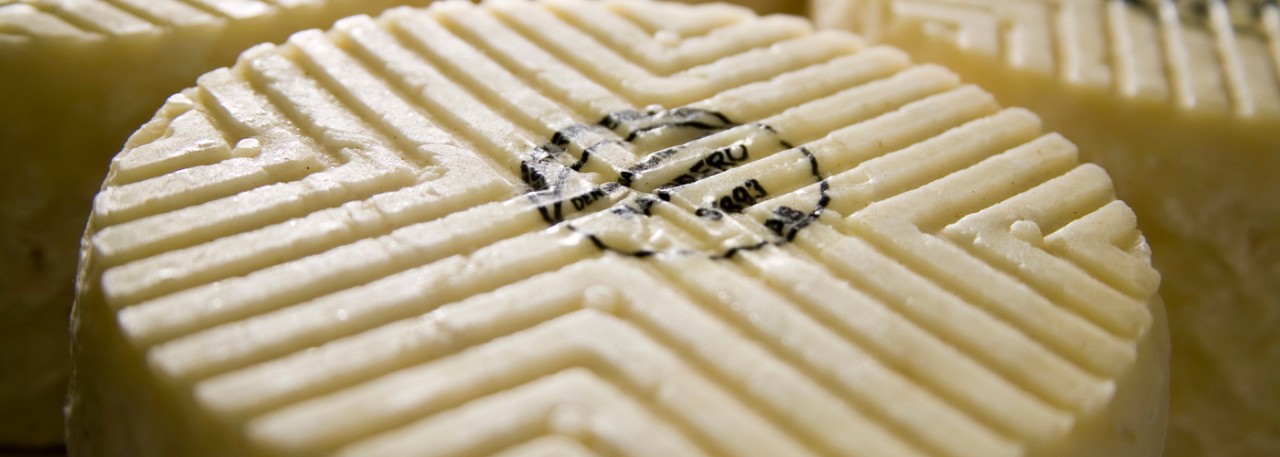.png.transform/rendition-xs/image_image%20(1).png)
Queso Majorero PDO
Cheese made from milk from goats of the Majorera breed, sometimes mixed with ewes’ milk, and ripened for a minimum of eight days.
Tasting notes
Balanced, intense flavor of goats’ milk. Slightly sharp and piquant in well-ripened cheeses. Characteristic aroma and creamy texture.
Other notes
Wheel-shaped, 6-9 cm (2½-3½”) high, 15-35 cm (6-14”) in diameter. Weight 1-6 kg (2lb 2 oz – 12 lb 12 oz). The rind, which is almost non-existent in lightly-ripened cheeses, bears the markings of the palm leaf bands round the sides and of the mold on the top and bottom. In medium-ripe cheeses it is white and in ripe cheeses, a brownish-yellow. It may be rubbed with pimentón (a Spanish type of paprika), olive oil or toasted cornmeal.When cut, the paste is compact and white, or slightly ivory-colored in ripe cheeses. Eyes, if any, are small.
The different types of cheese have the following physical and chemical characteristics:
- Tierno: 17.4% protein, 52.0% fat in dry matter and 50% dry matter.
- Semi-curado: 25.5% protein, 54% fat in dry matter, and 57% dry matter.
- Curado: 27.5% protein, 55.5% fat in dry matter, 63% dry matter.
Production / Processing method
The milk used must be clean and contain no colostrum, medications, preservatives, etc. which might have a negative effect on production, ripening and storing and on the cheese’s health and hygiene conditions.
Goats may be milked manually or by machine. The milk is filtered and coagulated using animal rennet, preferably from the dried stomachs of kids. During this process, the milk must be kept at a temperature of 28-32ºC (82-89ºF) for about one hour.
The resulting curds are cut until they form grains 5-15 mm (1/4–3/4”) , depending on the type of cheese to be made. They are then pressed to remove as much whey as possible.
The semi-pressed curds are then molded using plaited palm leaf or plastic bands or plastic or stainless metal molds imprinted with the marks of the traditional molds.
The cheeses may be salted either using dry salt or by immersion in brine at a maximum concentration of 20º Baumé for a maximum of 24 hours. The next day or after two days, they are turned and left to stand in a cool, well-ventilated place. On the third or fourth day, they are washed, preferably in whey, to remove any surplus salt and are then returned to a cool, dark, well-ventilated storage room, where they are turned regularly.
Ripe cheeses are rubbed with fat or oil (preferably olive oil) and sometimes with cheese fat and mold from previously ripened cheeses. Finally, a product is added to close the pores of the cheese to improve quality and prevent weight loss.
Geography / Relief and climate
The island of Fuerteventura measures 100 km (62 miles) from north to south and has a surface area of 1,659 km2 (0.38 sq miles). It is located in the south-east of the Canary Islands, and is the closest of the islands to Africa, at a distance of less than 100 km (62 miles).
One of the main topographical characteristics of the island of Fuerteventura is its low mountains. The highest, the Pico de la Zarza, reaches 807 m (2,648 ft) and lies to the south of the island on the Jandía peninsula. Its volcanic structure was formed by the sub-horizontal piling of basalt flows. The Macizo de Betancuria has more mountainous relief although altitudes are moderate, such as the Pico de la Atalaya at 752 m (2,500 ft).
Of special interest are the large areas covered by wind-blown organic sand forming dunes, known locally as jables. These are especially relevant along the island’s varied coastline where the beaches are large.
The island has unusual bioclimatic conditions because of the gentle relief of its mountains. The average annual temperature is 19.6-18.8ºC (67-66ºF), resulting in a very mild climate.
The predominant feature is aridity. Annual periods of rainfall are short, and torrential. Most of the island records less than 100 mm (4 inches) per year, except for the higher areas which sometimes receive the Trade winds so rainfall may reach 250 mm (10 inches). Rain usually takes the form of heavy downpours, causing torrential run-off on slopes. To avoid the loss of run-off water, dams have been built holding about 4 hm3. This water is used directly for farming or may infiltrate the soil, filling up aquifers.
Regulatory Council
Consejo Regulador de la DOP Queso Majorero
C/ Lucha Canaria, 12
35600 Puerto del Rosario, Fuerteventura (Las Palmas)
Islas Canarias
Tel: (+34) 928 532 593
info@quesomajorero.es
www.quesomajorero.es
Sources:
- Spanish Ministry of Agriculture
When cut, the paste is compact and white, or slightly ivory-colored in ripe cheeses. Eyes, if any, are small.


- Majorero 1
- Majorero 2

Puerto del Rosario (Canary Islands)
